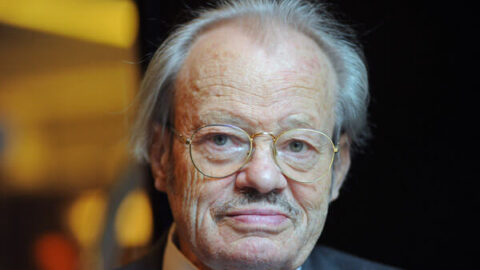 This season marks the 100th anniversary of the Vienna Concert House, a massive building with four stages that are (mostly) acoustically separate. It was opened officially on October 19, 1913, by Austrian Kaiser Franz Josef I a mere eight months before Archduke Franz Ferdinand was assassinated on June 28, 1914, and the First World War broke out. Fourty-five years later, in March, 1959, the new music ensemble die reihe performed its first concert in the Schubert Room of the Concert House, under the baton of ensemble co-founder Friedrich Cerha. In the fifty-five years since, this ensemble has premiered myriad new works by the century’s most illustrious composers. Both anniversaries were celebrated in the Mozart Room of the Vienna Concert House on Thursday, February 14, 2013, in a concert conducted by Mr. Cerha. Both conductor and ensemble sounded comfortably on home turf performing key works from the ensemble’s history. On the program, the perfectly subtle performance of miniatures by Stravinsky, Webern, and Cerha himself was complemented by a virtuosic rendition of Ligeti’s brilliant Chamber Concerto for 13 Instrumentalists.
This season marks the 100th anniversary of the Vienna Concert House, a massive building with four stages that are (mostly) acoustically separate. It was opened officially on October 19, 1913, by Austrian Kaiser Franz Josef I a mere eight months before Archduke Franz Ferdinand was assassinated on June 28, 1914, and the First World War broke out. Fourty-five years later, in March, 1959, the new music ensemble die reihe performed its first concert in the Schubert Room of the Concert House, under the baton of ensemble co-founder Friedrich Cerha. In the fifty-five years since, this ensemble has premiered myriad new works by the century’s most illustrious composers. Both anniversaries were celebrated in the Mozart Room of the Vienna Concert House on Thursday, February 14, 2013, in a concert conducted by Mr. Cerha. Both conductor and ensemble sounded comfortably on home turf performing key works from the ensemble’s history. On the program, the perfectly subtle performance of miniatures by Stravinsky, Webern, and Cerha himself was complemented by a virtuosic rendition of Ligeti’s brilliant Chamber Concerto for 13 Instrumentalists.

Conceived between Petruschka and The Rite of Spring, Igor Stravinsky’s Two Poems by K. Balmont (1911) and Three Poems on Japanese Lyrics (1912-13) share much in common with Anton Webern’s Four Songs for Voice and Orchestra op. 13 (1917-22) and Two Songs for Voice and Chamber Ensemble On Poems By Karl Kraus (1918/19). All four works have been fully distilled until only the most necessary sounds remain. Stravinsky’s melodic language in these two pieces, however, reflects much more the Russian influence on his writing during this period. Soprano Natalia Zagorinskaya performed a very interesting interpretation of these works. She sang with a subtle, straight tone, remaining quiet and controlled, sometimes singing under the orchestra. It was not an unemotional rendition, however: she let rip, making audible a fully-broken heart, at the end of K. Balmont.
Die reihe performed two more instrumental Webern works, Eight Fragments for Orchestra M. 190-197 (1911-13), arranged by Friedrich Cerha (1994) and Five Pieces for Orchestra op. 10 (1911-13) with unquenchable subtlety and beautifully-balanced tone colours. The mood of lush restraint continued through Cerha’s Fantasy After Cardew’s Fall ’60 for Seven Instrumentalists (1962/63). Born of Cerha’s efforts to simplify some of the notation of Cornelius Cardew’s nearly-impenetrable score, the Fantasy is structured into 27 short, discreet events. Although it is notated very differently than Webern’s work, there is an audible similarity between Fantasy and Webern’s brevity. Cerha, however, deals in a bit more drama than Webern, providing room for louder highs and quieter lows.

After all of these short, gestural works, in which the ear focuses in on the beautiful minutae of sound, György Ligeti’s Chamber Concerto for 13 Instrumentalists (1969/70) felt enormous. In four movements, this piece demonstrates Ligeti’s masterful ability to build an interesting idea with complete discipline through a coherent form. The second movement (Calmo, sostenuto) demonstrates this ability perfectly: a very quiet cluster chord is sustained through shifting tone colours, leading to contrapuntal, melodic fragments. This builds in small waves, somehow always maintaining clarity and balance in spite of all that is going on. A few minutes in, a similar but much more ominous cluster emerges, bringing a high and harsh event in the winds and strings. This period of maximum dissonance last for what feels like just the right period of time before it falls back into a wash of more consonant clusters, ending the movement softly. Perfectly paced, this intuitive structure is beautiful to hear. The ensemble chewed through the technical minefield of this work with complete clarity, with Cerha hardly breaking a sweat.
The Viennese adore their musical history, and display their famous, long-dead composers with as much pomp and period costuming as can be mustered. Luckily, the history of 20th century music is also rich in Vienna, and the concert marking this important anniversary demonstrated that this “new” tradition will also continue to thrive.
–
Caitlin Smith is a Canadian composer, currently based in Vienna. Follow her on Twitter: @tinyalligator.
























